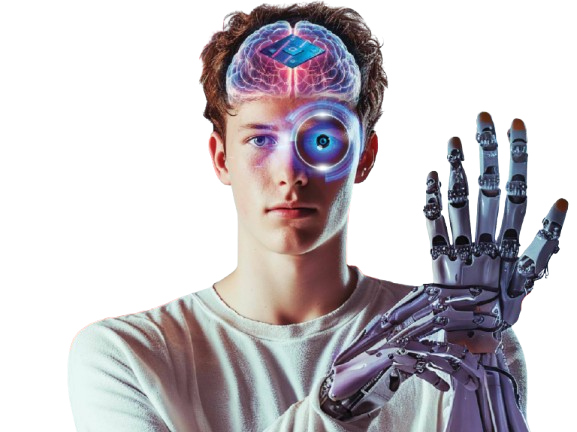कोशिश गोल्ड - मुक्त
IS THIS THE HUMAN OF TOMORROW?
How It Works UK
|Issue 200
HOW WIRES AND CIRCUITS ARE MINGLING WITH BLOOD VESSELS AND NERVES TO CHANGE THE COURSE OF HUMAN EVOLUTION

The world as we know it is on a one-way trajectory to a technological overhaul. With each year that passes, cybernetics and artificial intelligence are finding their way into every nook and cranny of society. Even the human body isn't exempt from this mechanical makeover: our smartphones have become an unintentional extension of our hands, while robotic limb enhancements and nanobot immunity are on the horizon.
But why would we let this technology take over our physiology?
The most common reason is to replicate an ability that has been lost or was missing at birth. Prosthetics are the best example of this, helping people regain motor functionality and movement. Since the early 1800s, engineers have created mechanical devices to mimic the function of missing limbs or appendages. But today some of the most advanced prosthetics in the world can tap into the signals zipping around the body's nervous system, allowing the user to control their prosthetic limb by will alone. Many battery-powered prosthetics can use the electrical signals of existing muscles to operate robotic fingers and arms.
They’re known as myoelectric prostheses, and they depend upon a series of electrodes in the socket of the device that make contact with the skin and muscle of the residual limb. When the wearer contracts the muscles involved in a certain action, such as grasping individual fingers, bending an elbow or rotating the wrist, the device can distinguish the electrical signal for each action and carry them out.

यह कहानी How It Works UK के Issue 200 संस्करण से ली गई है।
हजारों चुनिंदा प्रीमियम कहानियों और 10,000 से अधिक पत्रिकाओं और समाचार पत्रों तक पहुंचने के लिए मैगज़्टर गोल्ड की सदस्यता लें।
क्या आप पहले से ही ग्राहक हैं? साइन इन करें
How It Works UK से और कहानियाँ

How It Works UK
UNCANNY'S DANNY ROBINS
The creator and host of the BBC's Uncanny series tells us about his most chilling experiences while researching the show, and writing a ghost book for children
4 mins
Issue 208

How It Works UK
HOW FEATHERS GROW
A bird's proteinaceous plumage comes from the same source as our hair
1 mins
Issue 208

How It Works UK
New EV battery technology could power 500-mile road trips on a 12-minute charge
Scientists have used a neat chemistry trick to tackle a major challenge facing future batteries.
2 mins
Issue 208

How It Works UK
HOW AIR PURIFIERS WORK
These filtration devices clean a room's air of particles that can make a person sick
1 min
Issue 208

How It Works UK
Chinese scientists hunt for alien radio signals in a 'potentially habitable' star system
TRAPPIST-1 is a red dwarf star located about 40 light years away that hosts seven Earth-sized rocky planets, with at least three orbiting in the habitable zone where liquid water could exist.
2 mins
Issue 208

How It Works UK
WHAT HAPPENS WHEN WE DIE?
Our bodies are vessels for life, but in death they undergo a cascade of chemical and biological changes
3 mins
Issue 208

How It Works UK
WHY ARE KEYBOARDS QWERTY?
There's a reason why this seemingly random arrangement of letters is widely used on keyboard layouts
1 min
Issue 208

How It Works UK
A 'quasi-moon' discovered in Earth orbit may have been hiding for decades
A new paper describes a possible 'quasi-moon' of Earth, an interloping asteroid that may have been following our planet around for decades, undetected.
1 mins
Issue 208

How It Works UK
WHAT'S AN ANTI-DRONE GUN?
How these devices intercept and disable unmanned aerial vehicles
1 mins
Issue 208

How It Works UK
Dozens of mysterious blobs discovered inside Mars may be 'failed planets'
Giant impact structures, including the potential remains of ancient ‘protoplanets’, may be lurking deep beneath the surface of Mars.
2 mins
Issue 208
Listen
Translate
Change font size
